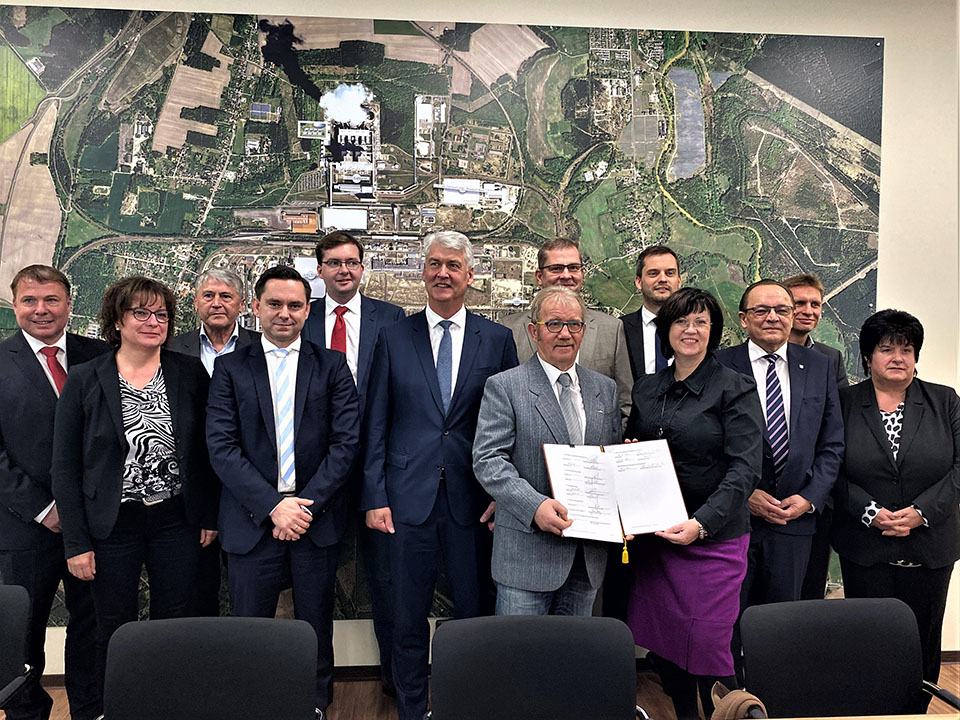Groundbreaking agreement for energy revolution signed – Green light for Lusatia reference power plant
Spremberg, 13.12.2019. The agreement for the “Lusatia reference power plant phase I” (RefLau) was signed last Friday at ASG Spremberg GmbH in Industriepark Schwarze Pumpe (an industrial estate in Brandenburg and Saxony) by all partners. This marks the beginning of the implementation of one of the most promising project ideas as part of the structural transformation in Lusatia.
The “Industrie Schwarze Pumpe” association in Spremberg and Lausitz Energie Kraftwerke AG (LEAG) in Cottbus are involved as the main partners along with two companies from the renewable energy sector in Energiequelle GmbH in Zossen and Enertrag AG in Gut Dauerthal. Steinbeis Technologietransferzentrum in Rostock and Centrum für Energietechnologie Brandenburg e.V. und GmbH in Cottbus (Cebra) are taking part in a scientific capacity. Lausitzrunde, Siemens AG, Ontras GmbH and 50 Hertz Transmission GmbH are also involved. The project came out on top at the national ideas competition “Real-world laboratories of the energy revolution” (Reallabore der Energiewende) of the Federal Ministry of Economic Affairs ahead of a number of applicants; a commitment of funding running into millions has already been made.
The Lusatia reference power plant project will be a storage power plant using hydrogen. It will be groundbreaking for the energy revolution in Germany.
In order to achieve added value in the long term, sample solutions will gradually be implemented in several steps in practice for the use of key technologies.
The aim is ultimately a modern power plant using renewable energy and therefore the provision of “green hydrogen”, the reconversion of which must be developed and implemented in practice. The Lusatia reference power plant encompasses the strategic objective of forming the future power supply based on renewable energy sources and hydrogen as chemical storage at Industriestandort Schwarze Pumpe.
It’s task is to provide all the system services required for a safe and stable operation of the electrical power supply system at all times and to the full extent, but also to operate the energy storage with hydrogen. Hydrogen will be automatically stored and withdrawn so that a power surplus from renewable energy systems and a temporary power deficiency can be overcome.
The power plant will also be designed so that it can be used to restore the grid in the event of a black-out. The test facility in Schwarze Pumpe will have a manageable output of up to ten megawatts and will road test the hydrogen technology. The experiences gained from this will then be used in the construction of larger power plants which can be operated at all locations where power plants currently use fossil fuels and these power plants can be completely replaced.
Further steps until 2030
The next steps will be completed in the first half of 2020, even when it comes to defining the exact location of the reference power plant in the industrial estate. An important factor in supporting the reference project is also the launch of the centre of excellence for entrepreneurs and commercial businesses (Kompetenzzentrum für Gründer and Gewerbe – KGG) in Schwarze Pumpe planned for April. This centre will focus on industry-related and scientific-based companies that will develop simultaneously with events at the industrial estate.
The planning for the reference power plant will be complete by 2022, the power plant will be built between 2023 and 2024 and the aim is to put the plant into operation in 2025. Various tests will then be carried out to verify its marketability and to adapt the technology until 2030; the output will gradually be scaled up to 100 megawatts. 600 to 800 jobs will be created at the location for the test phase of this technology alone.
The total investment amount for the Lusatia reference power plant project is approximately 100 million euros. The Federal Government will provide around 75 to 80 million of this amount and the other costs will be borne by the project partners.
Comments from the worlds of business and politics
Christine Herntier, Mayoress of Spremberg and spokeswoman of Lausitzrunde and integrated project partner is very pleased with the agreement: “There is not a better project for us than this one. We didn’t just want to be critics from the start of our commitment, but also part of the solution. The regional component was and is important to us. The local authorities are supporting the project. The engineers will now have the biggest contribution to make.” Herntier even sees her region as the future location for industry tourism. Manfred Heine, Mayor of the Spreetal community and Head of the Industriepark Schwarze Pumpe association adds: “We approached this great task with respect, but never with fear.” Gerhard Hänel from ASG Spremberg GmbH, who is also responsible for managing the industrial estate, is project coordinator: “Everyone knows where we will leave. We are specifically focusing on where we will start. We are creating a tangible reality with the reference power plant.” Hänel was the driving force of the “Ideenschmiede Lausitz” work group which was formed in Schwarze Pumpe back in 2017 as a result of the climate objectives that were discussed and strived for real alternatives to conventional power plants. Not only climate protection was discussed in this group, but also the associated energy and social issues. Hydrogen was talked about from the very beginning of the work group.
Background
The German energy revolution urgently requires a radical structural realignment of the current power plant and industry locations in a short space of time. A dramatic transformation lies ahead. Only the quickest possible use of innovations, especially in the technology sector will make this restructuring possible with long-term job security and regional added value. Lusatia with its power plant and industry locations, first and foremost the Schwarze Pumpe association site, must face the challenges and reinvent itself, especially in the power supply sector. As a pilot installation for the future power supply utilised for other power plant and industry locations, the Lusatia reference power plant represents an integrated solution for successfully facing the main challenges of the energy revolution.
On the one hand, it is designed to be able to take on all the functions of a conventional power plant – including all relevant system services and fully flexible operation based on a schedule. On the other hand, it also offers the possibility of decarbonising the heat, transport and industry sectors beyond the reconversion requirement by generating green hydrogen.
This highly-integrated and more innovative approach, in particular, corresponds to the original criteria of the real-world laboratories of the energy revolution.
However, the possibility of implementing this concept depends to a critical extent on whether the real-life laboratories being implemented actually create a framework which allows these projects to be realised.


